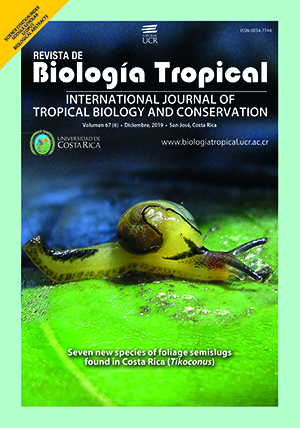Abstract
Introduction: The family Euconulidae is circumglobal, but only one subfamily, the Euconulinae, occurs in the American continent. Fourteen native euconulids, in three genera, have been reported from Costa Rica. Objective: In this paper I describe Tikoconus, a new genus of Euconulinae endemic to Costa Rica. Methods: I dissected alcohol-preserved euconulids collected in Costa Rica. I took photographs or electron micrographs or drew the shell, external anatomy, reproductive system, mantle cavity organs and radula. Results: The genus Tikoconus can be recognized by its semislug appearance and very thin and often flexible subglobose to subglobose-depressed external shell. Other distinctive features of the genus are a lack of black dots on the mantle and the presence of at least some dark blotches on the subpedal groove band. Internally, the urethra has a Z-shaped prolongation that almost reaches the mantle collar. The reproductive system has a distinctive external C-shaped penial gland that surrounds half of the penis circumference and is attached to the penis and to the penial caecum, but not connected to them by ducts. Also, there is an internal mono- or bi-lobulated extension in the penis. The epiphallus has a verge that enters into the penis. The penial sheath surrounds part of the penis, the epiphallus base and the penial retractor muscle insertion, but leaves the penial gland and the penis caecum free. The gametolytic gland is absent. I described two new subgenera: Tikoconus sensu stricto with seven new species-T. (T.) costaricanus sp.n. (type species), T. (T.) onca sp.n., T. (T.) andresi sp.n., T. (T.) katyae sp.n., T. (T.) alosii sp.n., T. (T.) subsilvanus sp.n.; and Bribriconus with only one species-T. (B.) thompsoni sp.n. All species have restricted distributions and are endemic to particular watersheds, except for T. costaricanus which occurs nearly throughout the central mountains of Costa Rican. This genus inhabits very wet, little disturbed tropical forests from 400 to 2 500 masl on the Atlantic slope and from 760 to 2 500 masl on the Pacific slope. The genus Velifera, the other semislug euconulid reported from Costa Rica, is kept as a valid taxon and I choose the specimen ANSP 48765 as lectotype of Velifera gabbi with the purpose of clarifying the application of the name to a taxon. Conclusion: A new euconulid genus and seven species were described.
##plugins.facebook.comentarios##

This work is licensed under a Creative Commons Attribution 4.0 International License.
Copyright (c) 2019 Zaidett Barrientos






